
Lovebirds are a small parrot species that get their name from their monogamous bonding and the long time they spends sitting with that other bird in nature. If you have these animals as a pet, you’ve probably noticed that they tend to exhibit different body language throughout the day. If you would like to know what this body language means, keep reading while we list the different behaviors you might see and what they mean to understand your pet better. After all, most lovebirds live 20 or 30 years, so you will be spending a lot of time together.
The 13 Lovebird Body Language Behavior
1. Happy Lovebirds
The first sign that your Lovebird is happy is that it will get a bit more chatty than usual and can sing for several hours. You will also notice that it slightly fluffs up the feathers on the head, making it look a little bigger, and they will do a lot of cheerful jumping around or singing on their favorite perch.

2. Relaxed
You can tell if your Lovebird is relaxed because it will be eating. Lovebirds only eat when they feel safe. It will also only preen its feet when it is comfortable, and if it does so while sitting on you, you are its friend. The feathers will be against the body but will be loose, and the bird will seem calm. It will usually sit with fluffy plumage and the cheek feathers pushed forward, giving the appearance of a shorter beak.
3. Mating
If you have a pair of Lovebirds, you will know when your birds start to mate because the male will chirp and sing to the female, and the plumage on the head will fluff out a little more than it does when the bird is happy. When there is no female present, the male bird will find something else to sing to and perform mating dances.
If the female is present, the male will bob his head up and down and feed the female to help encourage her to start breeding. The male may also start feeding other males and will even try to feed your finger. This action is the same it will use to feed its chicks. However, males can sometimes start to quarrel when the male is feeding, so you will need to split them up. If you notice your bird trying to mate with you, it is likely a male.

4. Angry
You can easily tell when your Lovebird is angry or feels threatened because it will fluff out all its feathers, lower its head and open its beak in a threatening stance. If whatever is threatening the bird continues, there is a good chance it will bite. If you see your bird doing this with a child near the cage, it’s best to separate them for a few minutes to try to determine the cause and let your pet calm down.
Children often have cartoon characters on their clothing and other accessories that your Lovebird can perceive as a threat. You may also notice this behavior between two birds, and it’s best to separate them, but you run the risk of getting bit if you do so. Lovebird bites don’t hurt bad but getting bit by your bird can be shocking if you are a new owner.
5. Irritable
Your Lovebird will get excited if you let it out of the cage to play with you. Unfortunately, too much excitement can cause it to be irritable. An irritable bird will take a similar stance to an angry bird, but it won’t ruffle the feathers as much. However, it will be much quicker to peck at your hand. If your pet gets irritable, it’s best to stop playing for a minute or two to let it calm down. Taking a break will also help teach that you won’t tolerate aggressive behavior.
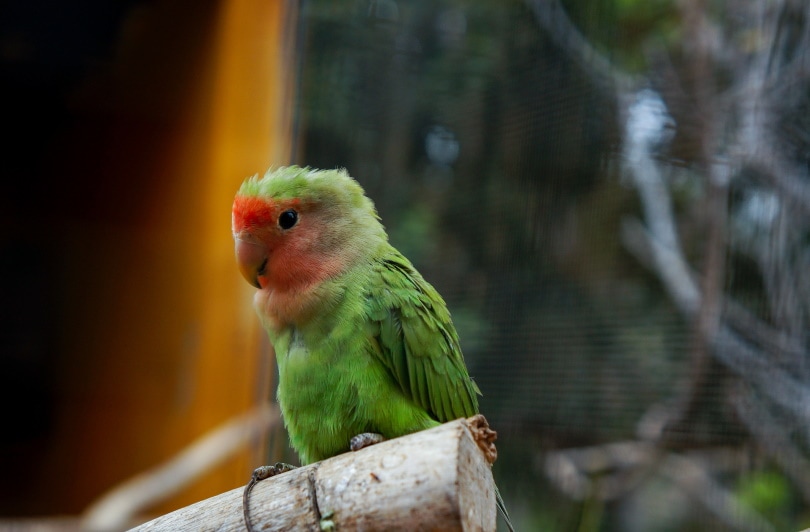
6. Fear
If your bird sees something it doesn’t like, it can become afraid. It’s not always easy to tell what is scaring your pet, but it’s usually something that looks like a predator, like a puppet or a cartoon character on a child’s outfit. Your pet will hold its feathers tightly against its body and will be in an alert position with a long neck. It will also attempt to move away from the perceived threat, and if it can’t, it will fly away or attack.
7. Curious
A curious Lovebird will stand at a slight distance from the object it is interested in, stretch its neck to get closer, and tilt its head back and forth to see better. Once it feels safe, it may attempt to move closer.
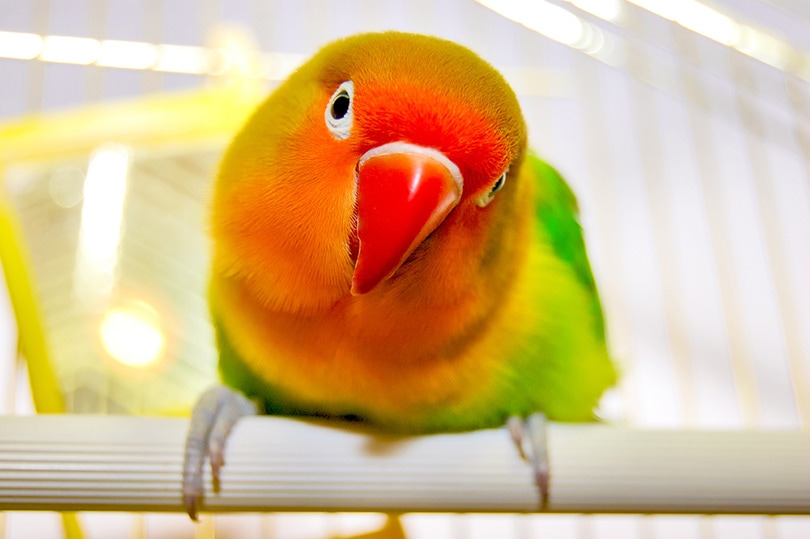
8. Too Warm
If your bird is feeling too hot because of the weather or because it’s been playing hard, you will notice that it starts to hold its wings out slightly from the body to help increase airflow, and you might also notice it panting. Overheating can also elevate the heart rate, so we recommend taking it somewhere cooler in your home or take a short break from activities until your Lovebird is back to normal.
9. Alert
If your Lovebird hears or sees something unfamiliar. It will stand erect, with both legs upright. The wings and plumage will be tight against the body, and it will be ready to fly. It will usually extend the neck and look to both sides to determine where the threat is.
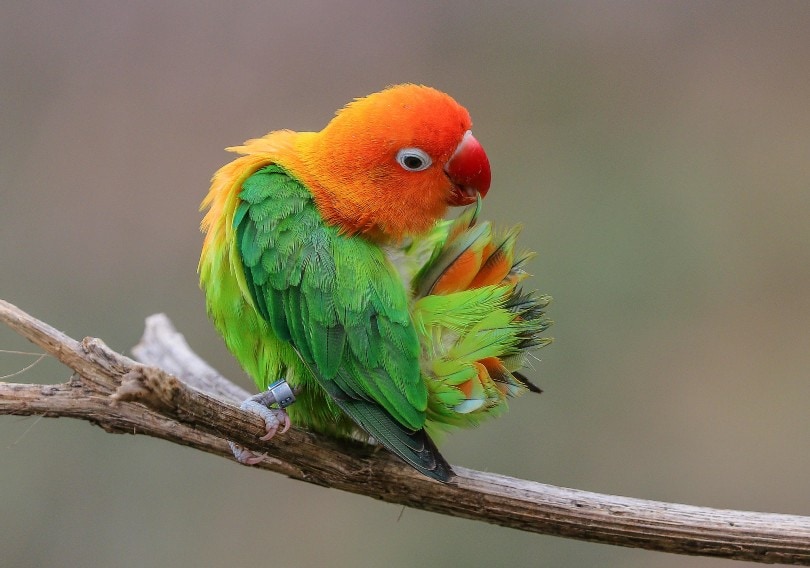
10. Sick
If your Lovebird is not feeling well, it will usually sit in the corner for long periods with ruffled feathers. You may also notice that its eyes are glossy. It’s important to take a sick bird to the vet immediately because, like cats, they don’t show signs of illness until it’s too late.
11. New Feathers
Many new owners mistakenly worry that their Lovebird has parasites when it is only getting new feathers. New feathers will make your bird quite itchy, and you will undoubtedly see it rubbing itself on branches and anything else it can find. It’s perfectly natural for your bird to do this, and it doesn’t have parasites or dry skin. You can even help your bird by gently massaging its head, making for a great bonding experience.
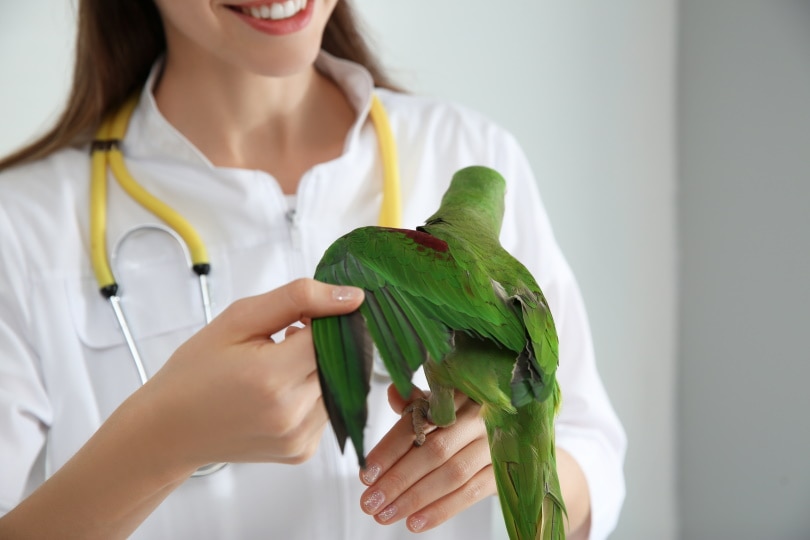
12. Ready to Poop
Your Lovebird will push its body down in a squat-like motion right before it poops. It often does this right before it takes flight to make itself lighter, and you can usually avoid getting hit if you watch your birds closely while handling them.
13. Sleepy
If your bird is tired, you will notice its eyes start to close, and blinking will be slow. It’s best to put the cover over the cage or take them to a dark place to get the rest they need to stay healthy. You may also hear a strange beak grinding sound right before it falls asleep, which is perfectly natural and is how they maintain their beak.
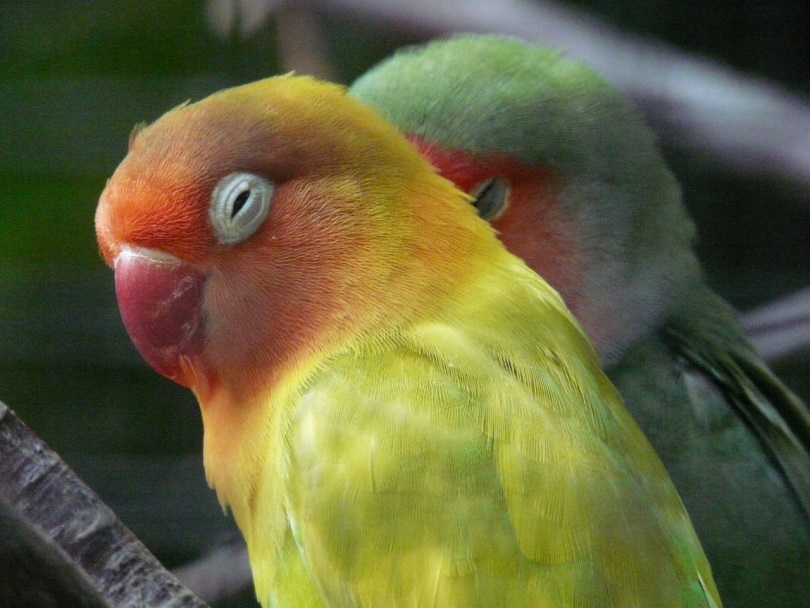
Summary
Out of all the body language you can learn from your Lovebird, the most important is telling if they’re sick since birds tend to hide illness extremely well. In the wild, it helps them from becoming easy prey, but it only makes it hard to provide the healthcare they need when under human care. Early detection is critical, so watch for your bird to be sitting in the corner with ruffled feathers for long periods and get them to the vet.
We hope you have enjoyed reading over this list and learned something new about your pet. If we have helped you understand your bird better, please share this guide to reading the body language of your Lovebird on Facebook and Twitter.
- Related Read: How to Bond With Your Lovebird (7 Proven Tips)
Featured Image Credit: Setiawan Heriadi, Pixabay







